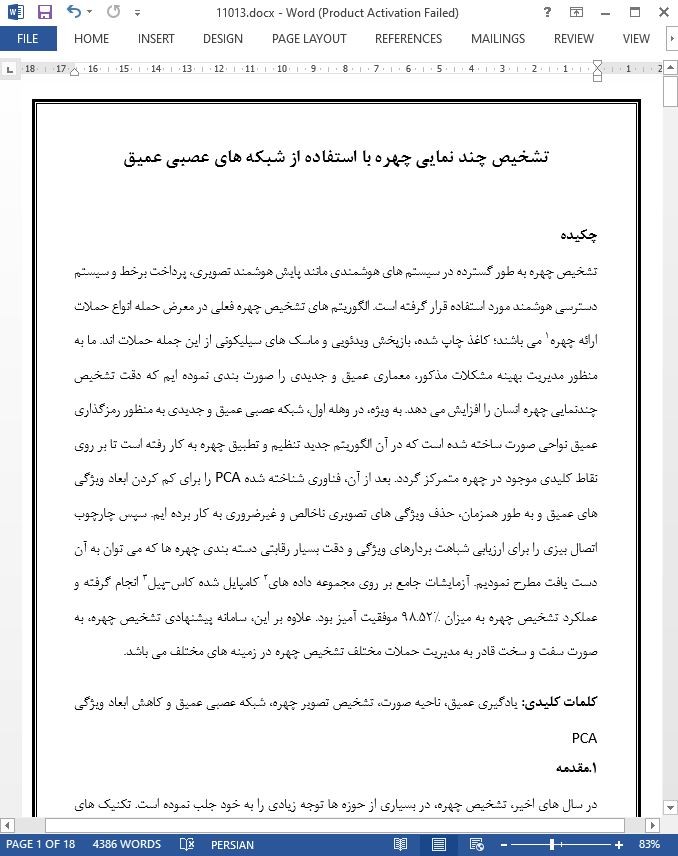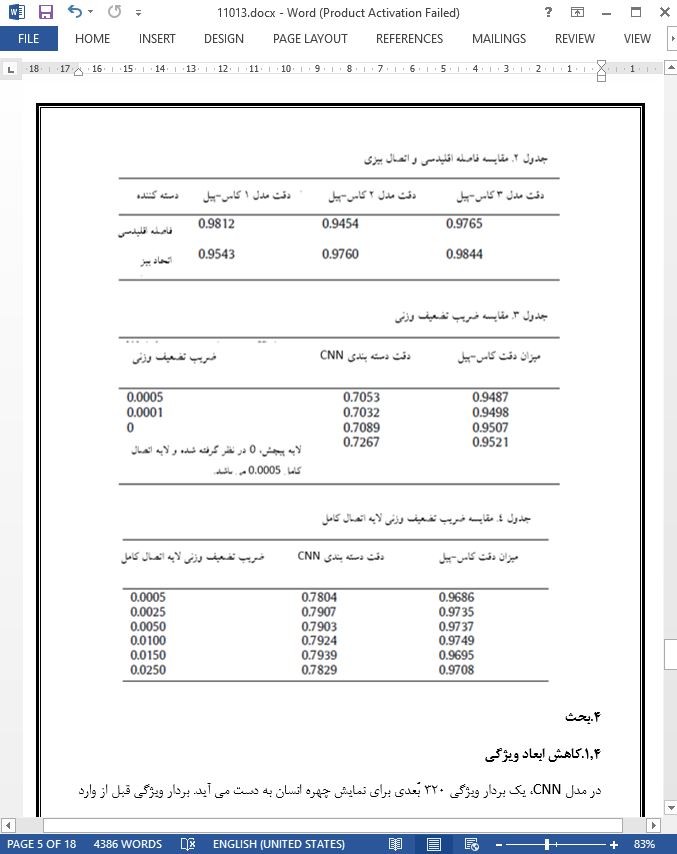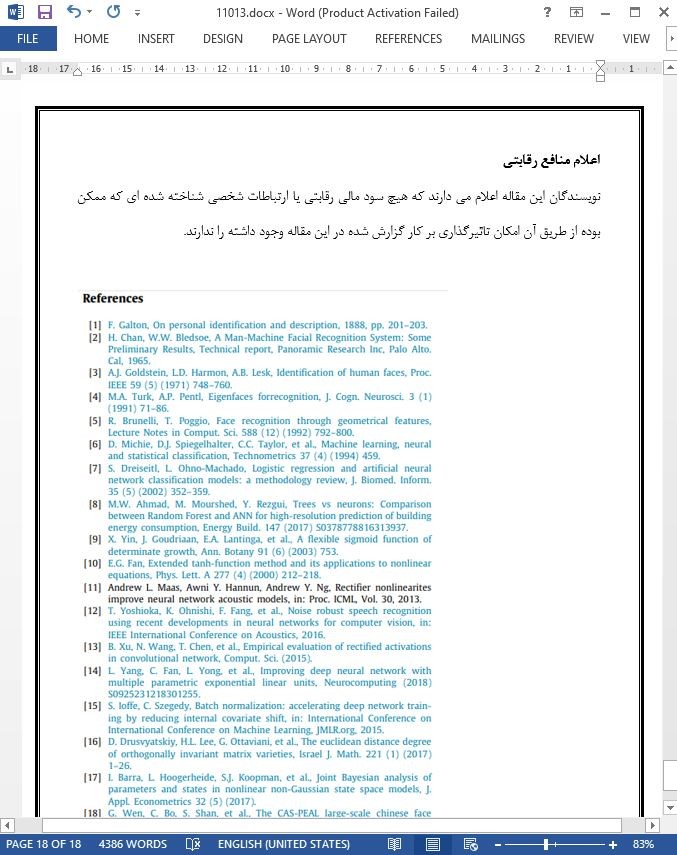
تشخیص چند نمایی چهره با استفاده از شبکه های عصبی عمیق
چکیده
تشخیص چهره به طور گسترده در سیستم های هوشمندی مانند پایش هوشمند تصویری، پرداخت برخط و سیستم دسترسی هوشمند مورد استفاده قرار گرفته است. الگوریتم های تشخیص چهره فعلی در معرض حمله انواع حملات ارائه چهره می باشند؛ کاغذ چاپ شده، بازپخش ویدئویی و ماسک های سیلیکونی از این جمله حملات اند. ما به منظور مدیریت بهینه مشکلات مذکور، معماری عمیق و جدیدی را صورت بندی نموده ایم که دقت تشخیص چندنمایی چهره انسان را افزایش می دهد. به ویژه، در وهله اول، شبکه عصبی عمیق و جدیدی به منظور رمزگذاری عمیق نواحی صورت ساخته شده است که در آن الگوریتم جدید تنظیم و تطبیق چهره به کار رفته است تا بر روی نقاط کلیدی موجود در چهره متمرکز گردد. بعد از آن، فناوری شناخته شده PCA را برای کم کردن ابعاد ویژگی های عمیق و به طور همزمان، حذف ویژگی های تصویری ناخالص و غیرضروری به کار برده ایم. سپس چارچوب اتصال بیزی را برای ارزیابی شباهت بردارهای ویژگی و دقت بسیار رقابتی دسته بندی چهره ها که می توان به آن دست یافت مطرح نمودیم. آزمایشات جامع بر روی مجموعه داده های کامپایل شده کاس-پیل انجام گرفته و عملکرد تشخیص چهره به میزان 98.52% موفقیت آمیز بود. علاوه بر این، سامانه پیشنهادی تشخیص چهره، به صورت سفت و سخت قادر به مدیریت حملات مختلف تشخیص چهره در زمینه های مختلف می باشد.
1.مقدمه
در سال های اخیر، تشخیص چهره، در بسیاری از حوزه ها توجه زیادی را به خود جلب نموده است. تکنیک های مربوطه می توانند در سیستم های مختلف به کار روند که از آن جمله اند: سامانه های قفل گشایی گوشی های هوشمند، پرداخت برخط و کنترل دسترسی ]3-1[. هدف تشخیص چهره، تمرکز یا کشف و ردیابی چهره انسان های مختلف با استفاده از تصاویر گرفته شده می باشد. این فن نقش بسیار مهمی را در تایید زیستی ایفا می کند. هر سامانه تشخیص چهره، با استفاده از دوربین، تصویری از چهره یک یا چند شخص گرفته و سپس چهره فرد یا افراد مذکور را با نمونه چهره هایی که قبلا در مجموعه داده های چهره به منظور انجام تشخیص، خوراک دهی شده اند مقایسه می کند. تشخیص چهره، ویژگی غیر تماسی را نشان می دهد که در آن ممکن است برای شخص شناسایی شده توصیفی نباشد که به طور ارادی به مجموعه ویژگی بپیوندد. در این روش، خروجی رد کردن فرد شناسایی شده، مشخص خواهد شد. در روش مذکور، فناوری تشخیص چهره انسان برای حوزه شناسایی زیست سنجی بسیار کاربردی است.
5. نتیجه گیری
الگوریتم تشخیص تصویر چهره مبتنی بر شبکه عصبی عمیق مورد پیشنهاد است. این الگوریتم شامل استفاده از شبکه عصبی درهم پیچیده برای استخراج ویژگی های چهره، استفاده از الگوریتم PCA برای کاهش ابعادی ویژگی و استفاده از روش اتصال بیزی برای داوری شباهت بردار می باشد. ما نهایتا به هدف بهبود دقت تشخیص تصویر چهره دست یافتیم. بعد از یک سری مقایسه های آزمایشگاهی، نتایج نشان می دهد که در مجموعه داده های کاس-پیل، دقت تشخیص تصویر چهره می تواند به 98.52% برسد.
Abstract
F Face recognition has been widely used in modern intelligent systems, such as smart video surveillance, online payment, and intelligent access control system. Existing face recognition algorithms are prone to be attacked by various face presentation attacks (face-PAs), such as printed paper, video replay, and silicone masks. To optimally handle the aforementioned problems, we formulate a novel deep architecture to increase the accuracy of multi-view human face recognition. In particular, in the first place, a novel deep neural network is built for deeply encoding the face regions, where a novel face alignment algorithm is employed to localize the key points inside faces. Subsequently, we utilize the well-known PCA for reducing the dimensionality of the deep features and simultaneously, removing the redundant and contaminated visual features. Thereafter, we propose a joint Bayesian framework in order to evaluate the similarity of feature vectors and highly competitive face classification accuracy can be achieved. Comprehensive experiments were conducted on our compiled CAS-PEAL dataset and achieved a 98.52% face recognition performance. Moreover, our proposed face recognition system can robustly handle various face recognition attack under various contexts.
1. Introduction
In recent years, face recognition has attracted lots of attention in plenty of domains. The relevant techniques can be employed in different intelligent systems, for example, smart phone unlocking, online payment and access control system [1–3]. The objective of face recognition is to localize/detect and track various human faces by leveraging the captured images. This technique plays a highly important role in biological verification. Each face recognition system captures a face image from one or multiple persons by utilizing a camera, and thereafter it compares the human face with the face samples that are already fed into the face database to fulfill the recognition. Face recognition exhibits the feature of non-contact, wherein it may not be descriptive for the identified person to deliberately join the feature collection. In this way, the output of rejecting the identified person will be identified. In this way, human face recognition technology is highly useful to biometric identification domain.
5. Conclusions
A face image recognition algorithm based on deep neural network is proposed. It includes the use of convolutional neural network to extract facial features, the use of PCA algorithm for feature dimensionality reduction, and the use of joint Bayesian method for vector similarity judgment. Finally, the purpose of improving the accuracy of face image recognition is achieved. After a series of experimental comparisons, the results show that on the CAS-PEAL data set, the accuracy of face image recognition can reach 98.52%.
چکیده
1. مقدمه
2. روش پیشنهادی
1.2. شبکه های عصبی
2.2. شبکه عصبی پیچشی (درهم پیچیده)
3.2. تابع فعال سازی
5.2. متریک شباهت
3. تجزیه و تحلیل و نتایج آزمایشگاهی
4. بحث
1.4. کاهش ابعاد ویژگی
2.4. ارزیابی شباهت ویژگی
3.4. ضریب پیچش وزنی
4.4. تابع فعال سازی
5. نتیجه گیری
Abstract
1. Introduction
2. Proposed method
2.1. Neural networks
2.2. Convolutional neural network
2.3. Activation function
2.4. Batch normalization
2.5. Similarity metric
3. Experimental results and analysis
4. Discussion
4.1. Feature dimension reduction
4.2. Feature similarity evaluation
4.3. Weight attenuation coefficient
4.4. Activation function
5. Conclusions
- ترجمه فارسی مقاله با فرمت ورد (word) با قابلیت ویرایش، بدون آرم سایت ای ترجمه
- ترجمه فارسی مقاله با فرمت pdf، بدون آرم سایت ای ترجمه



